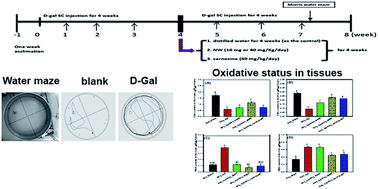Asn-Trp dipeptides improve the oxidative stress and learning dysfunctions in d-galactose-induced BALB/c mice
Abstract
The oral administration of Asn-Trp (NW) or carnosine (β-alanyl-L-histidine) dipeptides to D-galactose (Gal)-induced BALB/c mice was used to evaluate antioxidant activities in vivo. D-Galactose (Gal) was subcutaneously injected into the dorsal necks of mice daily for eight weeks to induce oxidative stress (Gal group). From the beginning of the fifth week, groups of NW10, NW40 (10 or 40 mg NW kg−1) or carnosine40 (40 mg carnosine kg−1) were administered orally concurrent Gal injection until the end of studies. It was found that the malondialdehyde (MDA) contents in these intervention groups were much lower than the Gal group. The mice in the NW40 group showed significant improvements compared to the Gal group in a reference memory task and probe trial test evaluated by Morris water maze. Mice in the intervention groups showed higher GSH levels and oxygen radical antioxidant capacity activities and lower MDA levels in the brain or liver tissues compared to the Gal group. The levels of advanced glycation end-products, including Nε-(carboxymethyl)lysine (CML) and argpyrimidine, in the brain tissues of the NW40 interventions are significantly lower compared to the Gal group. These results suggest that NW may be useful in developing functional foods for antioxidant and anti-aging purposes.


 Please wait while we load your content...
Please wait while we load your content...